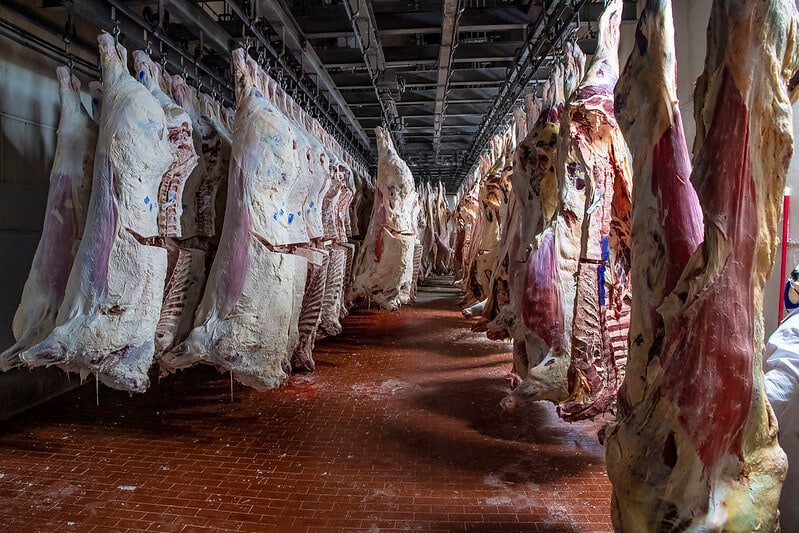OMAHA, NE — USDA released its January Crop Production, World Agricultural Supply and Demand Estimates (WASDE) Dec. 1 Grain Stocks and Winter Wheat Seedings reports.
USDA pegged final national average corn yield at a record 177.3 bushels per acre (bpa), well above the range of pre-report expectations. Production was pegged at 15.34 billion bushels (bb).
Soybean yields also climbed to a national average of 50.6 bpa. Production clocked in at 4.17 bb.
DTN Lead Analyst Todd Hultman sees Friday’s U.S. ending stocks estimates as bearish for corn and soybeans and neutral for wheat. He sees the world ending stocks estimates as bearish for corn, neutral for soybeans and slightly bearish for wheat. As for the Grain Stocks report, Hultman sees it as bearish for corn and wheat, only slightly bearish for soybeans.
CORN
U.S. production for 2023-24 crop was pegged at 15.342 bb, up 108 million bushels (mb) from December numbers. The national corn yield was increased 2.4 bpa to 177.3 bpa, with both production and yield setting records and higher than pre-report analysis had forecast.
Higher production rippled down to higher ending stocks for the 2023-24 crop at 2.162 bb, up 31 mb from the December forecast.
On the demand side, Feed and Residual use came in at 5.675 bb, up 25 mb. Total 2023-24 Food, Seed and Industrial use is pegged at 6.79 bb, up 50 mb. Ethanol use also was increased 50 mb and is forecast at 5.375 bb. Total domestic use is forecast at 12.465 bb, up 75 mb.
Exports for the corn crop are pegged at 2.1 bb, the same as December.
The farmgate price for the 2023-24 crop was dropped 5 cents to $4.80 a bushel.
Quarterly stocks for corn: Looking at usage and storage, corn stocks in all positions on Dec. 1, 2023 totaled 12.2 bb, up 13% from a year ago and the highest in five years. Of total stocks, 7.83 bb were stored on farms, up 16% from a year ago. Off-farm stocks were 4.34 bb, up 7% from a year ago. Usage for the quarter from September to December 2023 came in at 4.53 bb, compared to 4.21 bb for the same period last year.
Globally, beginning stocks for the 2023-24 new crop were raised .46 million metric tons (mmt) to 300.56 mmt. Production globally was raised 13.66 mmt to 1,235.73 mmt. Global exports were lowered .6 mmt to 200.89 mmt. Global ending stocks for the new crop are forecast at 325.22 mmt, up 10 mmt.
Despite the rise in global production, USDA lowered Brazil’s production 2 mmt to 127 mmt. Argentina’s production was held pat at 55 mmt.
Ukraine’s production was held pat at 30.5 mmt and Ukraine’s exports also were held at 21 mmt.
SOYBEANS
USDA raised its forecast for 2023 soybean production to 4.16 bb with a national average yield of 50.6 bpa. But while those estimates are higher than USDA’s previous estimates, it’s the smallest crop in four years.
USDA also trimmed harvested acreage in its Annual Crop Production report to 82.4 million.
In its quarterly Grain Stocks report, USDA pegged supplies on hand at 3 bb, down 1% from 2022. Stocks stored on-farms totaled 1.45 bb, while off-farm stocks stood at 1.55 bb. Indicated usage for September-November totaled 1.43 bb, 6% lower than the same time period in 2022.
As a result of the supply side changes, USDA’s forecast for ending stocks for the 2023-24 season came in at 280 mb, above the range of pre-report expectations. USDA made only one tweak to demand — a 3 mb cut to the residual.
The largest crop also resulted in a 15 cent drop in the national average farm gate price. It declined to $12.75 per bushel.
Globally, USDA’s stocks estimate for the 2023-24 growing year increased by less than 0.5 million metric tons to 114.60 mmt. USDA boosted Argentina production by 2 mmt to 50 mmt, while cutting Brazil’s expected output by 4 mmt to 157 mmt.
WHEAT
The agency estimates ending stocks at 648 mb, down from 659 mb from December’s report.
Seed demand is pegged at 64 mb, a decrease from 65 mb in December. Feed and residual use is estimated at 120 mb, unchanged from December.
Domestic use was estimated at 1.879 bb, a slight decrease from December’s estimate of 1.88 bb. Exports are estimated at 725 mb, unchanged from last month. The farmgate price is estimated at $7.20, down from $7.30 last month.
All wheat stored in all positions on Dec. 1 totaled 1.41 bb, up 8% from a year ago. On-farm stocks are estimated at 395 million bushels, up 9% from last December.
Off-farm stocks, at 1.02 bb, are up 7% from a year ago. The September to November 2023 indicated use is 357 mb, 23% below the same period a year earlier.
Globally, ending stocks increased to 260.0 mmt from 258.2 mmt in December.
Exports are estimated at 51.0 mmt for Russia and 14.0 mmt for Ukraine, both are slight increases from December.
Production in Australia was estimated at 25.5 mmt, an unchanged from last month. Production in Argentina was estimated at 15.0 mmt, unchanged from December.
WINTER WHEAT SEEDINGS
Farmers planted 34.4 million acres to winter wheat this fall, down 6% compared to last year and below the average pre-report estimate of 35.9 ma.
Kansas and Texas, the two largest acreage states, are expected to be down 7% and 8%, respectively. A record-low planted area is expected in Michigan and Utah.
USDA said area seeded to hard red winter wheat is expected to total 24.0 ma, down 5% from 2023. Planted acreage is down from last year across most of the growing region. The largest decreases in planted acreage are estimated in Kansas and Texas, while Montana is estimated to have a modest increase.
Soft red winter wheat area, at 6.86 ma, down 13% from last year. Compared with last year the largest acreage decrease is expected in Michigan, while the largest acreage increase is expected in Pennsylvania.
Farmers planted 3.54 ma to white winter wheat, a 5% decrease from 2023. Seeding was virtually complete in the region by the start of November.
LIVESTOCK
The January WASDE report focused on increased beef and pork production levels in 2024 compared to the December estimate. Beef production is estimated to increase by 120 million pounds during the 2024 marketing year, while pork production is projected to increase 240 million pounds.
Although this is not expected to have a significant impact in overall price levels in the long term, due to larger-than-expected production already factored into both cash and future prices, this will have an impact on the ability to sustain longer-term support in both live cattle and lean hog prices, as well as pork and beef cutout values over the upcoming weeks and months. The increased beef production is stated to be hitting the retail market in both the first and second quarter of 2024, with an estimated 65-million-pound gain in first quarter 2024, while second quarter increased projections are 59 million pounds.
Pork production increases are seen through the year, although the majority of the gains are developing in both the first and second quarter with 100-million-pound increases reported in first quarter, and 105-million-pound increase in the second quarter. This increased production level is expected to be carried over to increased total use, with most of the demand growth needing to develop in domestic markets.
Beef exports in the latest report are expected to fall 60 million pounds in 2024, while pork exports are projected to increase 20 million pounds. This will leave an increase of 2024 total use for beef increasing 225 million pounds from the December report, while total use for pork is projected to increase in 2024 from last months report by 220 million pounds. The impact of this increased production estimate follows the previous reports seen in the hogs and pigs, and cattle on feed reports seen in December, and so far has had little impact on overall futures prices, due to most of this bearish market news already factored into price levels.
This report is a confirmation that the next six months of beef and pork markets will continue to be bogged down with strong production levels, and the search for increased domestic demand growth will be the key to keep markets stable during the first half of 2024. Estimated price levels for live cattle is expected to remain stable, while annual projections for hogs has been reduced by $2 per cwt from the December report.
You can also access the full reports here:
— Crop Production: https://www.nass.usda.gov/…
— World Agricultural Supply and Demand Estimates (WASDE): http://www.usda.gov/…












